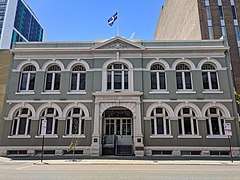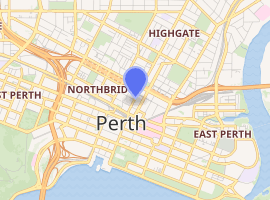Perth Trades Hall
The Perth Trades Hall is a historic trades hall building in Perth that has been occupied by various organisations of the Western Australian trade union movement. The building is now the WA headquarters of the CFMEU.
| Perth Trades Hall | |
|---|---|
 Perth Trades Hall building | |

| |
| General information | |
| Type | Heritage listed building |
| Location | Perth, Western Australia |
| Coordinates | 31.94934°S 115.86289°E |
| Type | State Registered Place |
| Designated | 30 July 2004 |
| Reference no. | 8783 |
Building history
Although a Trades and Labour Council (TLC) was established in Perth in 1891, finances to build a trades hall were not available until 1911, when Alick McCallum became general secretary of the Australian Labour Federation, as the TLC was then called.
Design and construction of the original trades hall building was largely due to the efforts of Ernest Henshaw. The three-storey neo-Georgian building was erected at 80 Beaufort Street, the site of Perth’s original Scotch College.
The foundation stone was laid by Prime Minister Andrew Fisher on 8 August 1911.[1] The hall was officially opened on 20 April 1912 by Premier of Western Australia, and former trades hall secretary John Scaddan.
In 1985 the building was sold and became the Delaney Gallery. The WA Heritage Council has listed it as Heritage Place No. 8783: Delaney Gallery (Trades Hall). A 2010 photograph in the register shows that the name "Trades Hall" has been reinstated above the portico.[2]
A new 'Perth Trades Hall', at Unity House, 77-79 Stirling Street, was opened on May Day, 2000. It provided offices and meeting rooms for trade unions, the Australian Labor Party and other community and political groups. The Trades and Labour Council (TLC), now known as UnionsWA, relocated in 2007 to the CSA Building at 445 Hay Street, Perth. WA Labor relocated to new headquarters on 54 Cheriton St, Perth, alongside United Voice.
In 2013 the building was purchased by the CFMEU West Australian State Registered Union so that the building would once again be used for its intended purpose of Trade Union business.[3] A significant renovation process was undertaken by Union workers restoring the building as far as possible to its original condition, with modern facilities provided for staff .On 29 June 2014 the building was re-opened by Michael O'Connor the National Secretary of the combined CFMEU National Divisions. At the official reopening he unveiled a plaque bearing the inscription "Back in the Hands of those who built it". The building now not only houses the CFMEU, but is regularly used by like minded organisations as a meeting venue.
References
- "The Perth Trades Hall". The West Australian. XXVII (7913). Western Australia. 10 August 1911. p. 6. Retrieved 30 April 2017 – via National Library of Australia.
- Image Details - Trades Hall, west elevation at State Heritage Office
- Kerr, Peter (2 May 2013). "Trades Hall back with union". The West Australian. Archived from the original on 21 April 2019. Retrieved 21 April 2019.
Further reading
- Monk, Ian. (1999) Perth's Trades Hall, 1912-1983. Papers in labour history, No.22 (Dec. 1999), pp. 6–20,
- Oliver, Bobbie. (2003) Unity is strength : a history of the Australian Labor Party and the Trades and Labor Council in Western Australia, 1899-1999 Perth WA : API Network, Australia Research Institute, Curtin University. ISBN 1-920845-01-1
External links
| Wikimedia Commons has media related to Perth Trades Hall. |
- Alex McCallum biography
- State Heritage Register entry, 30 July 2004, at State Heritage Office
- Assessment documentation, 30 July 2004, at State Heritage Office
- New Trades Hall: Officially opened by the Premier. Western Mail, 27 April 1912, p. 50, at Trove